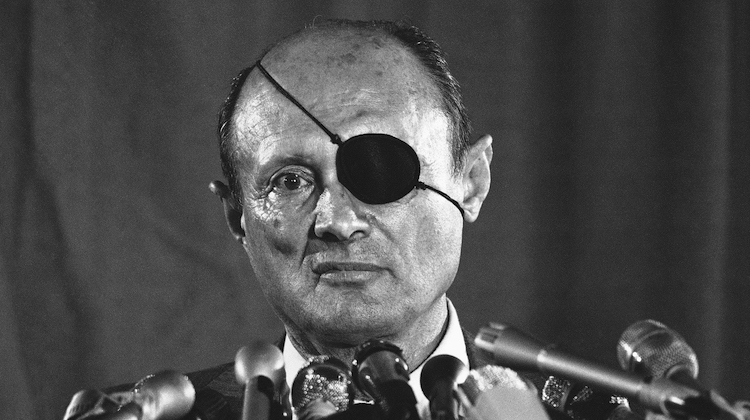Moshe Dayan’s Tragic Blunder
The worst decision in Israel's history still has extremely negative effects today.

Whenever Israel’s Temple Mount is in the news, one is reminded of the old joke in which two Americans, touring England, pay a visit to Runnymede. “It was here,” the guide proclaims, “that King John was forced to sign the Magna Carta, the first declaration of the rights of man, one of the important moments in the history of democracy.” One of the Americans raises his hand and asks when this occurred. “1215,” the guide responds. The American turns to his friend, holding his watch arm aloft. “It’s 12:30 now! We just missed it!”
All too often, people are apt to opine about a historic site without any elemental understanding of its history. Thus it was that when new Israeli minister of public security Itamar Ben-Gvir strolled for some 15 minutes on the Temple Mount in Jerusalem, apparently with the foreknowledge of Prime Minister Netanyahu, his visit was immediately condemned by the government of Jordan, as well as by State Department spokesman Ned Price. “We oppose any unilateral actions that undercut the historic status quo,” Price declared. “They are unacceptable. The president has previously underscored the need to preserve that historical status quo at the Haram al-Sharif/Temple Mount, as has the secretary.”
There was only one problem: Strolling on the Temple Mount in no way violates the so-called status quo, dating back to the policies adopted by then–Defense Minister Moshe Dayan after the Six-Day War—according to which, Jews are allowed to visit the Temple Mount but not openly pray there. That is exactly what Ben-Gvir did.
One reporter seems to have followed up, asking Price whether he knew what the terms of the “status quo” actually were. Price’s answer was a master class in doublespeak: “It’s a question for the parties themselves, including the Hashemite Kingdom of Jordan, whose role as the custodian of Jerusalem’s holy sites, again, we deeply appreciate.” We are thus in an Orwellian moment in which the “status quo” is whatever Jordan might consider it to be and in which the history of the Temple Mount can be redefined in the moment in order to disregard the rights of a Jewish state to the most important site in Jewish history. Following the visit to the site, Hamas immediately threatened repercussions, and the UN Security Council hurried to meet about the non-violation of a sacred status quo.
The current contretemps, like all others concerning the Temple Mount, reveals that Dayan’s original decision was a terrible mistake, the worst in Israel’s history. Rather than pacifying Jewish–Muslim relations, the Dayan compromise instead encouraged Israel’s enemies to deny any Jewish rights of access to the Mount. The general’s decree was not only strategically misguided but also terribly unjust, as it has created a situation in which the only faith community in Israel that cannot fully access its most sacred site is made up of religious Jews. One can be a fierce critic of Ben-Gvir, or any other leader in the current government, and still understand that there is something profoundly wrong with the current situation. Yaakov Katz of the Jerusalem Post stated the matter succinctly:
Why is Israel under threat from a terrorist group for allowing Jews to pray at Judaism’s holiest site? Why is it okay for everyone else to pray there and not for Jews? And why do these Palestinian groups get away with making such threats?
Sadly, it is not only in the State Department and the United Nations that Jewish rights on the Temple Mount are disregarded. Times of Israel editor David Horovitz chose to not only condemn Netanyahu’s acceptance of Ben-Gvir’s visit but also to defend Dayan’s original decision to block Jews from praying at the Temple Mount:
There is an argument to be made for permitting wider access and the right to pray for Jews at the site of the biblical Temples. In part, this argument charges that defense minister Moshe Dayan, in electing not to fully realize Israel’s sovereignty over the Mount immediately after its breathtaking capture in the 1967 war, helped facilitate the resonant Palestinian lie that the Jews have no connection to our ancient homeland—for surely, if the Temple Mount was historically ours, religiously ours, we would not have handed it back to them.
Dayan self-evidently thought otherwise. Anxious to avoid a full-on confrontation with the entire Muslim world, and utilizing the halachic argument that Jews should not set foot on the Mount for fear of defiling the sacred ground where the Temple and its Holy of Holies once stood, he allowed Jordan’s Muslim Waqf to continue to administer the compound’s holy places.
Netanyahu, Horovitz continued, had “wisely” adopted Dayan’s approach previously, but now the prime minister had “sanctioned” an act of “potential pyromania.” Horovitz’s account leaves out the fact that the decision of the ardently secular Dayan was founded on total disregard for what the Temple Mount meant to religious Jews.
After his paratroopers broke through Jordanian lines in 1967 and reached the site, Mordechai Gur exultantly exclaimed that “the Temple Mount is in our hands.” Dayan, in contrast, infamously reflected, “What do I need this Vatican for?” As the Israeli journalist Nadav Sharagai has documented, Dayan’s actions were based in the presumption that the Temple Mount is not of any religious significance to Jews at all:
Dayan thought at the time, and years later committed his thoughts to writing, that since the Mount was a “Muslim prayer mosque,” while for Jews it was no more than “a historical site of commemoration of the past…one should not hinder the Arabs behaving there as they do now and one should recognize their right as Muslims to control the site.”
But of course the Temple Mount is more, for Jews, than a commemorative locale of the past: It is the holiest site in Judaism, the one toward which Jews pray all over the world, because they believe that God dwells there in a special way. Dayan’s decision did indeed facilitate Palestinian claims, rampant today, that no Temple ever stood in Jerusalem and that the entire Jewish connection to Jerusalem is a fabrication. This is why more and more religious Jews are realizing that visiting the site is essential. It is not only far-right figures who are visiting the Mount. Entering certain sections of the Mount in a manner sanctioned by Jewish law is becoming more and more mainstream among Orthodox Jews. And that is why opposition to Jewish access to the Mount is growing more and more frantic by the day.
All this points to a profound irony. The return of Netanyahu has been met with the journalistic gnashing of teeth and the rhetorical rending of garments by writers and public figures about the danger that the (democratically elected) government of Israel poses to democracy. And yet it is these very critics who are often so dismissive of the most elemental of democratic injustices: denying Jews in Israel the right to visit, and to pray at, Judaism’s holiest place. Perhaps, when it comes to the history of the democratic liberties of mankind in the eyes of those who piously intone on the subject, it is only the rights of religious Jews that do not matter.
This essay was originally published in Commentary.
The worst decision in Israel's history still has extremely negative effects today..
The worst decision in Israel's history still has extremely negative effects today..

